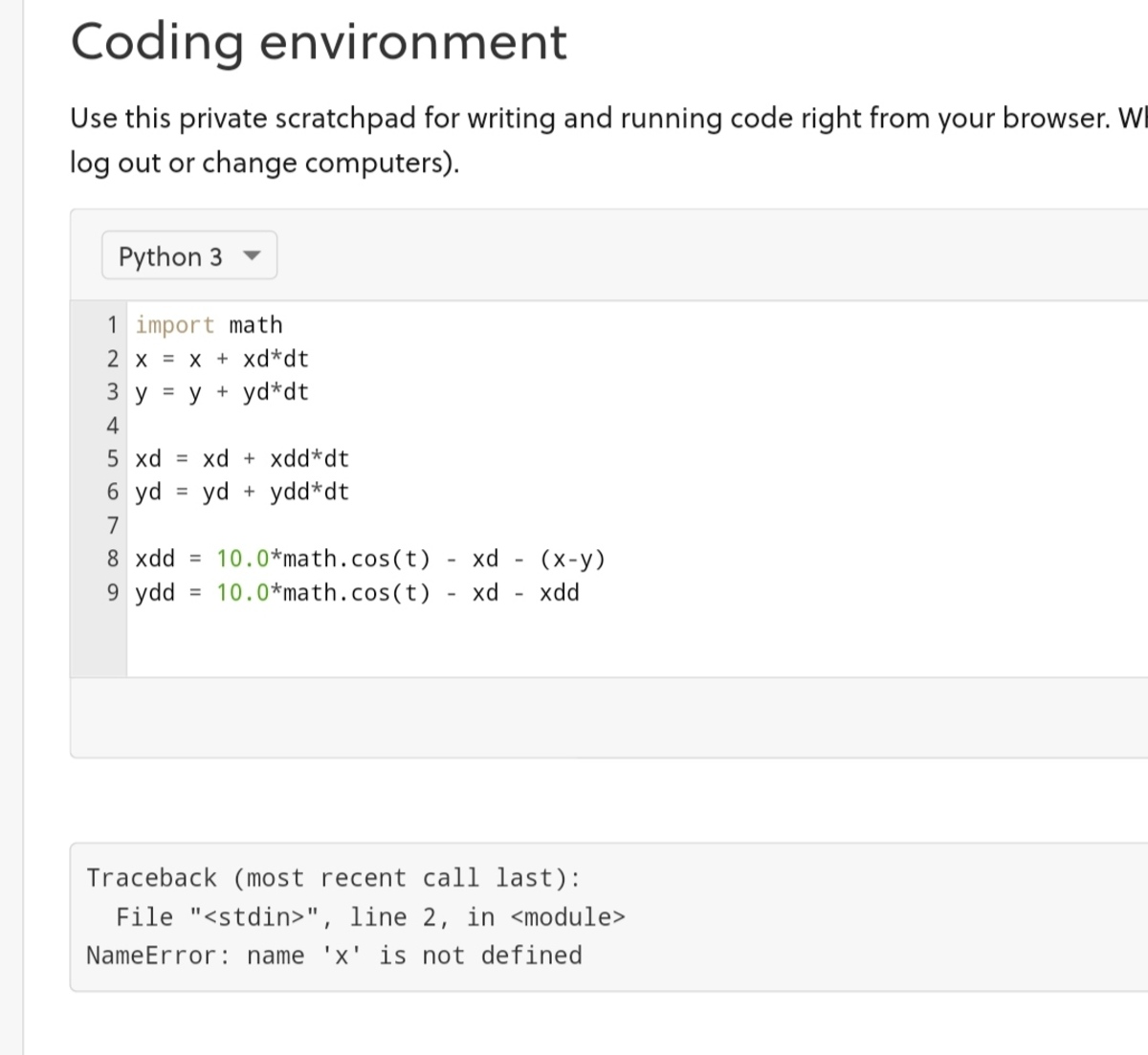Differential Equations
I was solving this particular pair of differential equation.
Both \(x\) and \(y\) are function of \(t\)(time)
\[10 \cos t-\dot{x}-\ddot{x}-\ddot{y}=0\]
Where and are single and double derivaties of with respect to (time) , respectively.
Is there any general form of solution, or some technique through Laplace transformation.
Any help will be appreciated.
Thanks in advance.
No vote yet
1 vote
Easy Math Editor
This discussion board is a place to discuss our Daily Challenges and the math and science related to those challenges. Explanations are more than just a solution — they should explain the steps and thinking strategies that you used to obtain the solution. Comments should further the discussion of math and science.
When posting on Brilliant:
*italics*or_italics_**bold**or__bold__paragraph 1
paragraph 2
[example link](https://brilliant.org)> This is a quote# I indented these lines # 4 spaces, and now they show # up as a code block. print "hello world"\(...\)or\[...\]to ensure proper formatting.2 \times 32^{34}a_{i-1}\frac{2}{3}\sqrt{2}\sum_{i=1}^3\sin \theta\boxed{123}Comments
@Steven Chase @Karan Chatrath
For something this complex, your best bet is probably numerical integration. Here is how it would look in Python (explicit Euler)
Log in to reply
@Steven Chase Sir the code is not working
Log in to reply
Yeah, it requires more code to actually run. I'll post the complete code soon
Log in to reply
@Steven Chase by the way I am very curious to know that how I will get x and y as a function of time because, python always gives results in numerical answer .
So I am very excited see that how python will do it?
Log in to reply
@Lil Doug Some differential equations can't be written as a function of time, like this one. This one is a nonlinear second order ODE; it is therefore extremely hard (or even impossible) to write a function of time of x.
Take the pendulum with drag:
θ¨=−gsin(θ)+Clθ˙
There are (as of now) no analytical solutions for the differential equation, as to the function θ. The one you've posted above is much harder than the pendulum equation already.
@Steven Chase sir can you post a python based solution of my latest problem.
Thanks in advance.
Hope I am not disturbing you.
Log in to reply
Hello. It is up now
Here is the full code, with some initialized values and plotting.
Log in to reply
I want to know; some people do Explicit Euler in an inverted order; acceleration, velocity, then position, but you've done it in the opposite way. Is there a major difference in the two orders?
Log in to reply
I doubt it makes too much difference. I basically taught myself how to do these things. So it wouldn't surprise me if my style was a bit unorthodox.
Log in to reply
@Steven Chase Do you use time-domain simulation as part of your day-to-day engineering?
Log in to reply
I do indeed. For simple things, I use little hand-crafted state-space simulations. For larger and more complex applications, we have more sophisticated (and much more expensive) time-domain simulation tools.
Log in to reply
@Steven Chase have a look on last 5 hour notifications
@Steven Chase How do you choose this values of x,x˙,y,y˙ are all these with random, or these value are basically a set, which are folloing the pair of differential equations.
Log in to reply
You can initialize the position and velocity any way you want. And then the initial accelerations are determined by the differential equations.
Log in to reply
@Steven Chase But how
x=5,x˙=6,y=7,y˙=8
So these are my assumed values, now how to find acceleration?
Log in to reply
Re-arrange your second equation to solve for the x acceleration. Then plug that into your first equation and re-arrange to solve for the y acceleration.
@Lil Doug If you have any questions about Explicit Euler, ask me, if Steven Chase's busy.
Log in to reply
I think he is lazy instead of busy.
Log in to reply
@Lil Doug Lol; just ask me your question. If it's about differential equations or numerical solving, I'm sure I can answer it. I taught myself that stuff a while ago, like him.
Log in to reply
@Krishna Karthik Thanks
By the way, I have posted a mechanics problem, don't forget to solve and post a solution
@Steven Chase who said that the value of x is 1 ??
I am again very much curious to know your method
Log in to reply
I just chose some values to initialize the simulation with